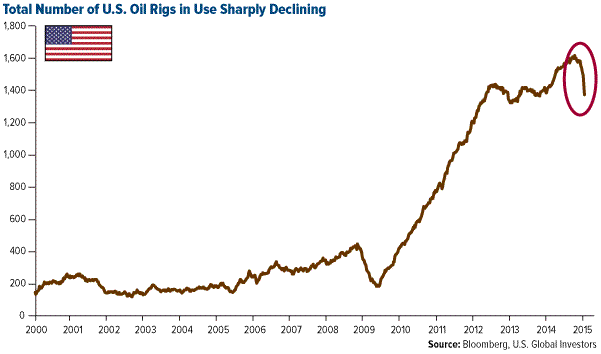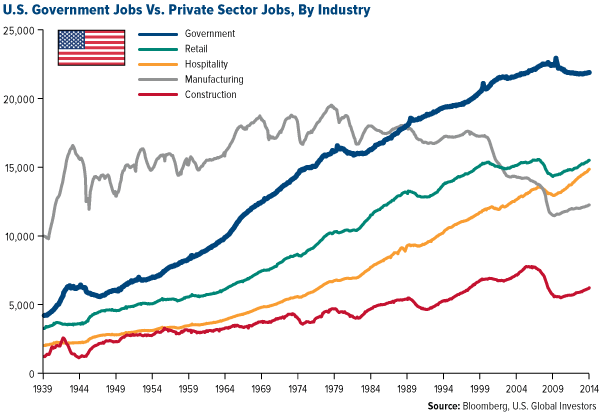7 Things about Saudi Arabia You Need to Know
Economics / Saudi Arabia Jan 30, 2015 - 10:00 AM GMTBy: Frank_Holmes
 A week ago we learned that the king of Saudi Arabia, Abdullah bin Abdulaziz Al Saud, passed away at the age of 90. Following the announcement, crude oil immediately spiked 2.5 percent over uncertainty of how this might affect the Middle Eastern kingdom’s position on keeping oil production at current levels.
A week ago we learned that the king of Saudi Arabia, Abdullah bin Abdulaziz Al Saud, passed away at the age of 90. Following the announcement, crude oil immediately spiked 2.5 percent over uncertainty of how this might affect the Middle Eastern kingdom’s position on keeping oil production at current levels.
But the new leader, King Salman bin Abdulaziz Al Saud, has already tamped down this uncertainty, stating that Saudi Arabia will hold to the decision made at last November’s Organization of Petroleum Exporting Country (OPEC) meeting.
All of this speculation just shows that Saudi Arabia is indeed the 800-pound gorilla when it comes to oil. Until very recently, it was the world’s top oil producer and exporter, before the American shale boom catapulted the U.S. into first place. Now, however, with prices less than half of what they were in July, many U.S. oil companies have been forced to shut down rigs, effectively slowing down output.

These events got me curious to dive deeper into Saudi Arabia’s economy and the extent to which it’s dependent on crude revenues. Below are some of the most interesting facts, gathered from a September case study by Richard Vietor and Hilary White of Harvard Business School.
- Despite beliefs to the contrary, Saudi Arabia requires a breakeven price of $80 per barrel of oil. True, the stuff is easy and inexpensive to extract in Saudi Arabia’s desert—the prevailing notion is that one need only stick a straw in the ground and oil comes gushing out—but to afford its bloated social spending program, the government needs prices to be much higher. Right now, oil revenues make up a whopping 90 percent of the country’s budget.
- Recognizing that its economy and energy portfolio are too oil-dependent, the kingdom is seeking ways to diversify. Before his death, King Abdullah ordered that other sources of energy be pursued, including nuclear and renewable energy. State-owned Saudi Aramco, the largest oil producer in the world, is currently ramping up exploration for natural gas. The company estimates that only 15 percent of all land in the nation’s borders has been adequately explored for the commodity.
- Saudi Arabia is nearing completion of a 282-mile high-speed rail line connecting the holy cities of Mecca and Medina. It’s unclear how many Saudis will use the trains, though, since fuel prices are extremely low as a result of government subsidization. Prices are so low, in fact—a gallon of diesel is less than $0.50—that it has led to excessive and wasteful use of energy resources that could be reserved or exported instead.
- Saudi Arabia maintains a strong pro-business climate to reel in foreign investors. It offers low corporate taxes (20 percent), no personal income taxes and attractive perks, including land, electricity and free credit. Because of these efforts, the country boasts the highest amount of foreign investment in the Middle East—$141 billion in the past five years alone.
- Saudi Arabia, believe it or not, has the largest percentage of Twitter users in the world. One of the main reasons for this is that more than half of its 29 million citizens are under the age of 25. As is the case in India, which also has a high percentage of young people, this is seen as an opportunity for the country’s future productivity.
- However, the kingdom has high unemployment among not just young people but also women. About 30 percent of working-age young people are without jobs; the figure is 34 percent for women. The country also has a shockingly low labor force participation rate of 35 percent. Saudi Arabia relies on cheap migrant workers, who now make up about 30 percent of the population.
- A vast majority of Saudis work for the government. Only about 10 percent of working Saudis are employed by private companies. Why? Workers can make either $400 a month on average in the private sector, where working conditions tend to be dubious at best, or $2,000 a month in the public sector. In 2011, about 800,000 new private-sector jobs were created, but of these, 80 percent went to foreign workers.
But this trend is not restricted to Saudi Arabia. As you can see in the chart below, here in the U.S., government jobs growth has broadly outpaced all other industries over the years.

This saps intellectual capital from the real engine of innovation and ingenuity, the private sector. A robust private sector is necessary to create and foster successful companies such as Apple, held in our All American Equity Fund (GBTFX) and Holmes Macro Trends Fund (MEGAX). The tech giant’s iPhone 6 sales led the way to a record earnings report of $74.6 billion—the largest corporate quarterly earnings of all time.
Make sure you’re subscribed to our award-winning Investor Alert to receive the best insight on oil, gold and emerging markets!
Want to receive more commentaries like this one? Sign up to receive email updates from Frank Holmes and the rest of the U.S. Global Investors team, follow us on Twitter or like us on Facebook.
By Frank Holmes
CEO and Chief Investment Officer
U.S. Global Investors
U.S. Global Investors, Inc. is an investment management firm specializing in gold, natural resources, emerging markets and global infrastructure opportunities around the world. The company, headquartered in San Antonio, Texas, manages 13 no-load mutual funds in the U.S. Global Investors fund family, as well as funds for international clients.
All opinions expressed and data provided are subject to change without notice. Some of these opinions may not be appropriate to every investor.Standard deviation is a measure of the dispersion of a set of data from its mean. The more spread apart the data, the higher the deviation. Standard deviation is also known as historical volatility. All opinions expressed and data provided are subject to change without notice. Some of these opinions may not be appropriate to every investor. The S&P 500 Stock Index is a widely recognized capitalization-weighted index of 500 common stock prices in U.S. companies. The NYSE Arca Gold BUGS (Basket of Unhedged Gold Stocks) Index (HUI) is a modified equal dollar weighted index of companies involved in gold mining. The HUI Index was designed to provide significant exposure to near term movements in gold prices by including companies that do not hedge their gold production beyond 1.5 years. The MSCI Emerging Markets Index is a free float-adjusted market capitalization index that is designed to measure equity market performance in the global emerging markets. The U.S. Trade Weighted Dollar Index provides a general indication of the international value of the U.S. dollar.
Frank Holmes Archive |
© 2005-2022 http://www.MarketOracle.co.uk - The Market Oracle is a FREE Daily Financial Markets Analysis & Forecasting online publication.



